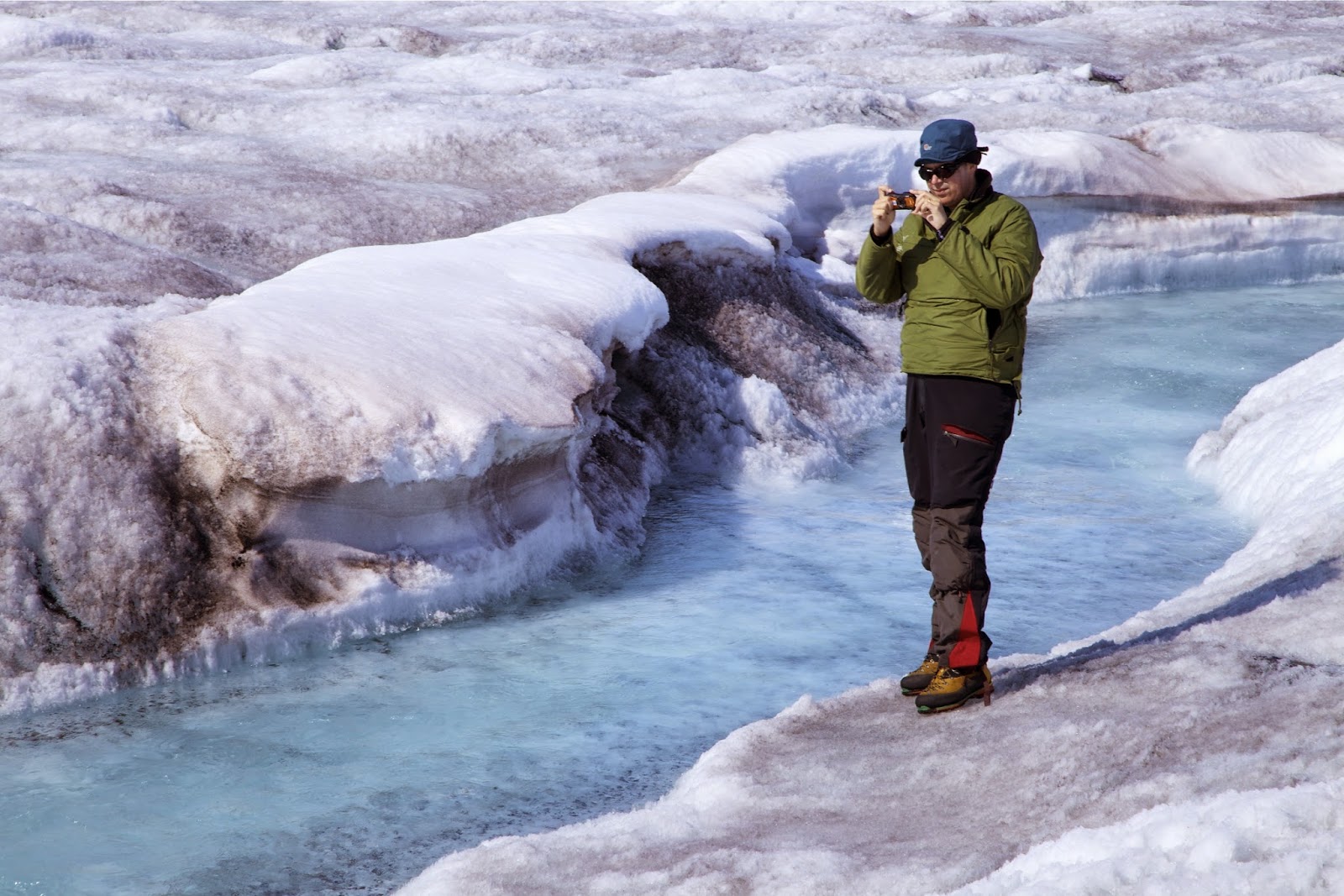Aberystwyth University scientist wins international award for glacier research
Aberystwyth University scientist Dr Arwyn Edwards has won an international award in The Microbiome Awards for his work on microbes in glaciers.
Dr Edwards is a microbiologist at the Institute of Biological, Environmental and Rural Sciences at Aberystwyth.
The award follows a decade of research and a 3 month research marathon during the summer of 2014 in Greenland, Svalbard, the Swedish Arctic and the Alps with still more work to do in South Georgia.
The Microbiome Awards provide young extraordinary scientists with funding and recognition to carry out scientific work in the field of microbiome research. A microbiome is a collective of microorganisms in a particular environment.
A recently published paper by Dr Edwards and colleagues at Aberystwyth University in the journal Wiley Interdisciplinary Reviews: Water reveals that the fate of Earth’s biggest stores of freshwater - glaciers and ice sheets – is closely linked to the lives of the smallest life-forms, microbes, living within them.
Dr Edwards said; “Much attention is focused on the future of glaciers and ice sheets because of their sensitivity to warming climates. Melting glaciers and ice sheets will affect the livelihoods, food and water security of hundreds of millions of people. Greenland may feel like a world away from us in the UK, but its ice sheet holds the equivalent of 7.5 metres of sea-level rise and as this melts it risks catastrophic effects on coastal erosion and sea defences here.”
Dr Edwards argues that the study of microbial processes in glacier environments will be important to understand how glaciers and ice sheets respond to climate change.
“Very crudely, we can think of glaciers as having a “bank account”, with credit being supplied as fresh snowfall, and debit being paid as ice melts. We have compiled an evidence base that microbes are important creditors and debtors to this glacial bank account.”
The paper describes how the “credit” is accumulated as microbial proteins in clouds help catalyse the formation of snowflakes, and microbes live in snowpacks, and “debit” is taken as microbial ecosystems darken the ice surface, increasing the amount of the sun’s energy absorbed by the ice, a so-called “biological albedo feedback” for glaciers.
Dr Edwards added; “We have taken to describing these microbial influences as a “germ theory” for glaciers because of the implications for how glaciers work”.
The paper builds on current research at Aberystwyth University on glacier ecosystems.
Co-author, glaciologist Dr Tristram Irvine-Fynn said; "Using sophisticated techniques in flow cytometry, we calculated the number of microbes living in the surface of glaciers worldwide. We were shocked to find numbers comparable to well-known habitats such as rainforest soils or the surface of the oceans".
“These microbes may be tiny, but they are important. We need to understand this accumulation of microbes in more detail to see how this albedo effect multiplies the impact of climate change on melting glaciers", Dr Irvine-Fynn added.
The association between microbes and ice runs deep as it includes microbes buried underneath glaciers.
Microbial geochemist, Dr Andrew Mitchell is also co-author on the paper. Dr Mitchell was co-principal investigator of the US National Science Foundation’s successful project to drill into Antarctica’s Sub glacial Lake Willans.
Dr Mitchell said; “Glacial ice covers 11% of Earth. We didn't know until a decade ago that life could survive underneath the ice, but as a result of our work we know how microbes "eat" rocks to survive under the ice, and produce methane, a powerful greenhouse gas".
The team is set to investigate further the links between ice and life as it is setting out to map the biology of glacial ice across the Arctic and Alps, with fieldwork in Svalbard, Greenland, the Canadian and Swedish Arctic and Austrian Alps.
The work is funded by the Royal Society, Natural Environment Research Council, European Union and Climate Change Consortium of Wales.
The team will then work with BSc students in Biological Sciences and MSc Glaciology students, linking cutting-edge research with teaching at Aberystwyth University.
“Hopefully our fieldwork will help provide a snapshot of how microbial life in glaciers responds to and magnifies the change in glaciers and ice-sheets at a key point as our climate warms”, said Dr Edwards.
Photo: Dr Arwyn Edwards surveying the Greenland Ice Sheet. Credit: Sara Penrhyn Jones
Intervew: Interview with Dr Arwyn Edwards is available on the Aberystwyth University Youtube channel: http://youtu.be/Ki0smC4u34o
Publication:
A germ theory for glacial systems? by Edwards, A., Irvine-Fynn, T., Mitchell, A. C. and Rassner, S. M. E. (2014) http://onlinelibrary.wiley.com/doi/10.1002/wat2.1029/abstract
WIREs Water. doi: 10.1002/wat2.1029
Earth Microbiome Project:
http://microbiomeproject.com/
Intervew: Interview with Dr Arwyn Edwards is available on the Aberystwyth University Youtube channel: http://youtu.be/Ki0smC4u34o
Publication:
A germ theory for glacial systems? by Edwards, A., Irvine-Fynn, T., Mitchell, A. C. and Rassner, S. M. E. (2014) http://onlinelibrary.wiley.com/doi/10.1002/wat2.1029/abstract
WIREs Water. doi: 10.1002/wat2.1029
Earth Microbiome Project:
http://microbiomeproject.com/



Comments